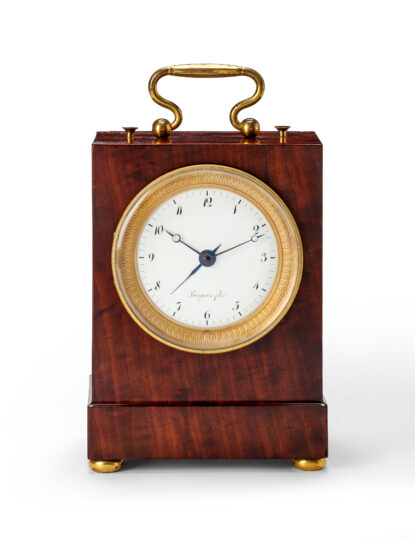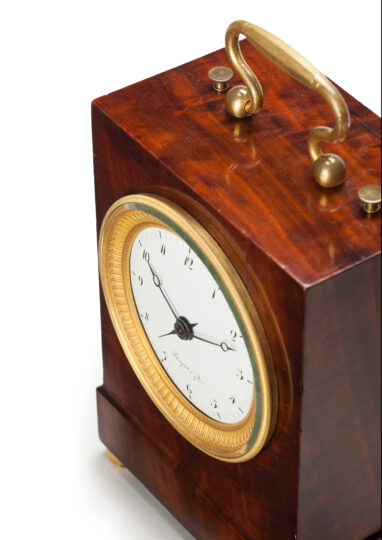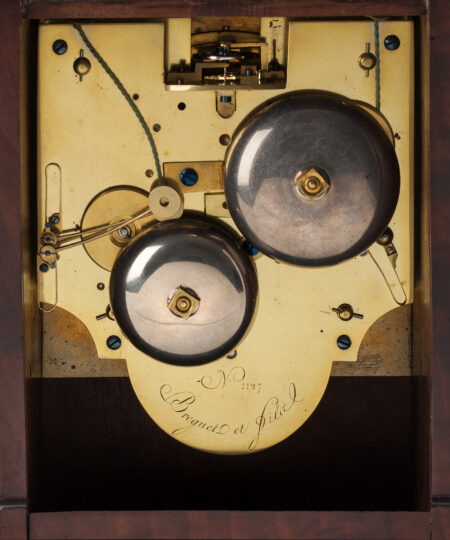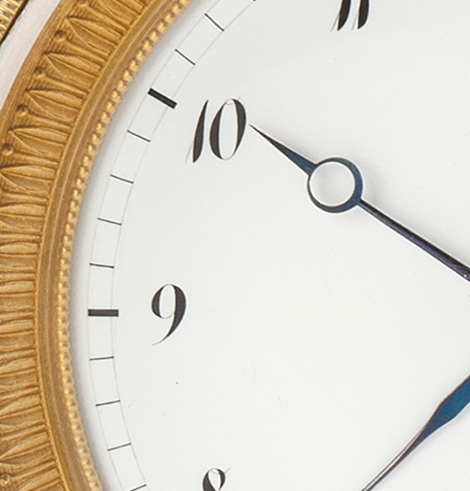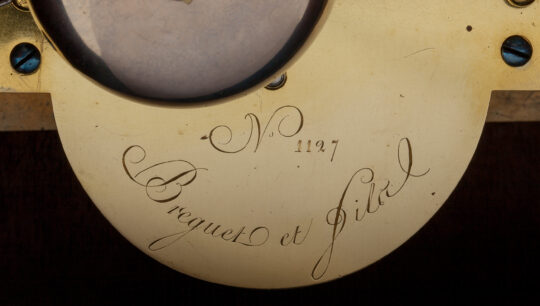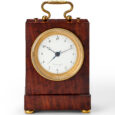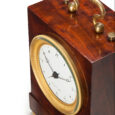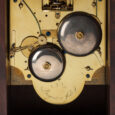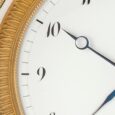CARRIAGE CLOCK Breguet et Fils No 1127 Ca. 1823
M&R120
CARRIAGE CLOCK
Signed Breguet et Fils No 1127
Circa 1823
France
Movement
The spring-driven brass plated movement consists of a going train with a Robin platform escapement and adjustable ‘Breguet’-balance. It also has a striking train on request, which indicates the hours and quarters on two bells, mounted on the backplate. The clock has an alarm that can be wound by a gilt brass button on the top of the case, the other button is for the repeater. The makers have signed and numbered the clock on the backplate Breguet et Fils No. 1127.
Dial
The white enamelled dial has an Arabic chapter ring with hour, five-minute and minute divisions. The time is indicated by a delicate pair of blued-steel ‘Breguet’ hands. The straight alarm hand is also made of blued steel. The dial is protected by a convex glass set in a gilt brass bezel. Upon opening this bezel the going train can be wound below the 6. Above the12 is the regulation to adjust the going train.
Case
The austere mahogany veneered wooden case has a removable panel at the back to access the movement. On the top there are two buttons for the alarm and the striking, with in the middle a gilt brass carrying handle. The case rests on four gilt brass bun feet.
Certificate
This clock has a Breguet certificate according to which it was sold on 6 December 1823 to the widow Manuel for FFr. 1700,=.
Duration 1 week
Height 23,5 cm
Width 14 cm
Depth 9 cm
Literature
George Daniels, The Art of Breguet, London 1974.
H.M. Vehmeyer, Clocks. Their origin and development 1320-1880, Volume II, Gent 2004 p. 955-959.
Abraham-Louis Breguet (1747-1823)
Abraham-Louis Breguet, born in Neuchâtel, Switzerland, was about fifteen years old when his stepfather sent him to Versailles to be apprenticed to the watch trade. He attended evening classes at the Collège Mazarin and learned mathematics, probably finishing his study around 1767. He emigrated to Paris a year later with his mother, stepfather and sisters, and in 1775 married Marie-Louise L’Huillier. They opened their business on Quai d’Horloge 51 soon after, now number 79, located in the centre of the watchmakers district near Pont-Neuf. It took five years of hard work for Breguet to establish his reputation. There are no records of watches manufactured before 1787, but it is evident that Breguet was interested in perfecting the mechanics of the self-winding watch, and realized that his future lay in using his special talent for ingenious and complex new horological designs, destined for the royal houses of Europe. The Duc d’Orléans in 1780 and Marie Antoinette in 1782, possessed self-winding watches, or perpétuelles as Breguet described them, and this is proof of his early success. He developed these perpétuelles in the following years and in 1786 began to manufacture them in large numbers. We can see from the company’s records that the manufacture of a perpétuelle was very expensive and in 1787 he secured a partnership with Xavier Gide, an established dealer in clocks and watches, as a means of acquiring additional capital for the business. This was not a lasting success, however, and the two men probably did not get on due to their opposing characters and unfortunately their partnership dissolved in 1791. Gide was a fiery revolutionary, whereas Breguet aspired to aristocracy and moved in noble and court circles. The French revolution disrupted Breguet’s life in Paris and he left in 1793 with his son and sister-in-law and traveled to Genève, Neuchatel, and finally to Le Locle, but they returned to Paris on 20 April 1795 and established their company at the same address: Quai d’Horloge. He must have felt at home here as he was extremely productive, and many of his important inventions and most exceptional creations were produced during this period. Breguet had already invented an important winding-key in 1789 (later named after him) and continued with the montre perpétuelle (1795), the Tourbillon regulator (1795)XX=5, the pendule sympathique (1795) and the montres à tact (1796-1800). In 1807 Breguet took his son Antoine-Louis, who studied watchmaking under John Arnold in England, into full partnership. The last ten years of Breguet’s business life were extremely successful and most of the crowned heads of the world could be counted as his clients. He must have been a happy man and was lucky to receive every possible honour during his lifetime. Already made Horloger de la Marine by Louis XVIII, he was also made Chevalier de la Légion d’Honneur, a member of the French Board of Longitude, and in 1816 was elected to the Académie Royale des Sciences. This creative watchmaker died rather suddenly on 17 September 1823 in Paris.

